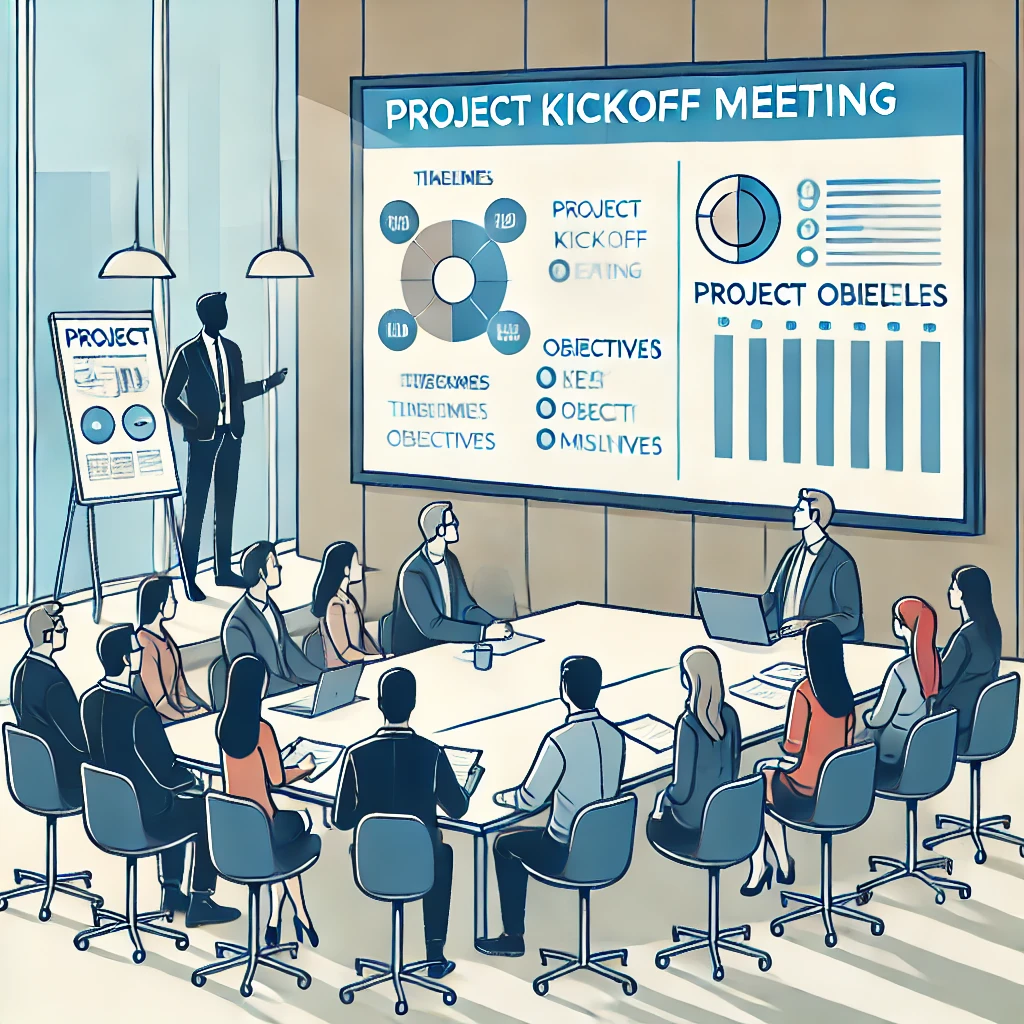
A project kickoff meeting is the initial step in bringing a project team together and setting the foundation for success. It marks the official start of a project and is designed to align the team, establish goals, define roles, and clarify expectations. This meeting is crucial because it sets the tone, direction, and vision for the project. Let’s explore the process, importance, and the role a Project Manager plays, along with guidelines on how to run an effective project kickoff meeting.
What is a Project Kickoff Meeting?
The project kickoff meeting serves as a formal introduction to the project for all stakeholders involved. It’s an opportunity for everyone to understand the project’s objectives, deliverables, timelines, and responsibilities. This meeting typically includes the project sponsor, project manager, key team members, and sometimes external stakeholders.
Importance of a Project Kickoff Meeting
The project kickoff meeting is vital for several reasons:
- Sets the Direction: This meeting sets the roadmap for the project, ensuring that everyone is clear on the goals, vision, and scope.
- Aligns Stakeholders: It’s a forum to bring together internal and external stakeholders, aligning their interests and expectations.
- Clarifies Roles and Responsibilities: It ensures that every team member understands their role, reducing confusion and overlap of responsibilities.
- Risk Awareness: Discussing potential risks early on helps in anticipating challenges and planning mitigation strategies.
- Builds Team Collaboration: It fosters collaboration, as participants get to know each other, laying the groundwork for open communication and teamwork throughout the project lifecycle.
The Role of the Project Manager in the Kickoff Meeting
The Project Manager (PM) plays a central role in the success of the kickoff meeting. They are responsible for:
- Facilitating the Meeting: As the meeting leader, the PM ensures that all key points are covered, that the meeting stays on track, and that all participants are engaged.
- Setting Clear Expectations: The PM outlines the scope, timeline, milestones, and deliverables, ensuring that everyone is clear on what is expected from them.
- Communicating the Project Vision: The PM shares the project’s objectives and strategic alignment with broader organizational goals to motivate the team.
- Answering Questions: The PM addresses any concerns or questions, ensuring that stakeholders are comfortable and confident moving forward.
- Risk Identification: The PM facilitates the discussion of potential risks and mitigation strategies, setting the stage for proactive risk management.
The Process of a Project Kickoff Meeting
- Preparation
- Create an Agenda: List the key topics to be discussed, including project overview, scope, timelines, roles, risks, and next steps.
- Invite Key Stakeholders: Ensure all relevant team members, sponsors, and stakeholders are present.
- Review Project Documentation: Prepare to present high-level documents such as the project charter, scope statement, and preliminary timeline.
- Introduction
- Welcome: The PM opens the meeting with introductions, especially if members haven’t worked together before.
- Meeting Objectives: The PM outlines the goals of the kickoff meeting to set the tone and focus.
- Project Overview
- Scope and Objectives: Present the overall project scope, key objectives, and expected outcomes.
- Timeline and Milestones: Share the high-level timeline and critical milestones to set expectations on deliverables and deadlines.
- Roles and Responsibilities: Clarify team roles, sponsors, and stakeholders to establish accountability.
- Communication Plan
- Reporting Mechanism: Outline how updates will be communicated and the frequency of status reports.
- Communication Channels: Establish tools for collaboration and communication (email, meetings, project management software).
- Risk Discussion
- Risk Identification: Encourage the team to brainstorm potential risks.
- Mitigation Plans: Outline preliminary risk management strategies to avoid or mitigate potential issues.
- Q&A Session
- Allow time for questions and discussions to clarify doubts, align expectations, and address any concerns.
- Next Steps
- Summarize the key takeaways and outline immediate next steps, such as scheduling future meetings, assigning tasks, or finalizing project plans.
Guidelines for Effectively Holding a Kickoff Meeting
- Be Prepared: Ensure that the PM is well-prepared with all necessary documents and data to answer questions and provide clarity.
- Engage Participants: Keep the meeting interactive by encouraging questions and discussions to ensure all participants are on the same page.
- Focus on Clarity: Avoid jargon or overly technical details. The goal is to make sure that everyone, regardless of their role, understands the project’s vision and their contribution.
- Stick to the Agenda: Time is valuable, so stick to the agenda and keep the meeting focused.
- Record Decisions and Action Items: Document the outcomes of the meeting, including decisions made, action items assigned, and the owners of those tasks.
- Follow Up: Send out meeting notes to all participants, summarizing key points, next steps, and deadlines. This helps reinforce accountability and ensures that the team is aligned moving forward.
Conclusion
The project kickoff meeting is more than just a formality; it’s an essential step in setting a project up for success. A well-executed kickoff ensures clarity, sets expectations, and aligns the team with the project’s goals. The Project Manager’s role in facilitating the meeting, communicating the vision, and ensuring alignment cannot be understated. By following the process and adhering to best practices, project teams can launch their projects on a solid foundation, increasing the likelihood of successful outcomes.
